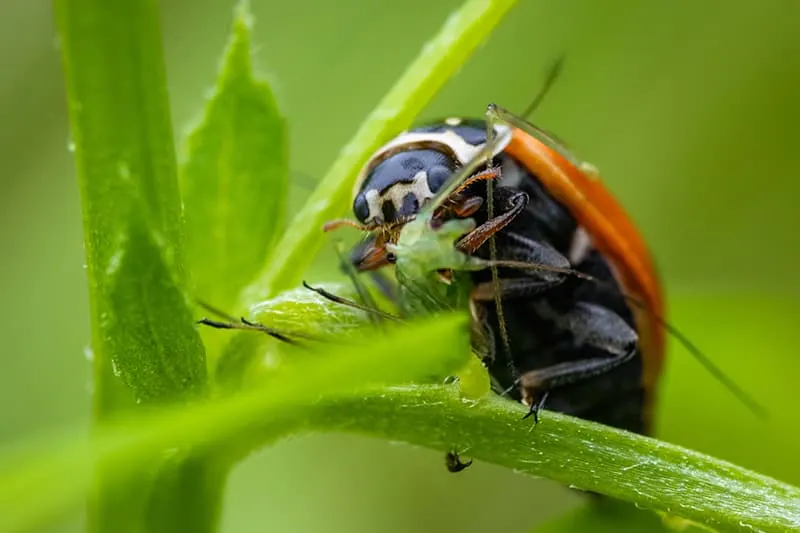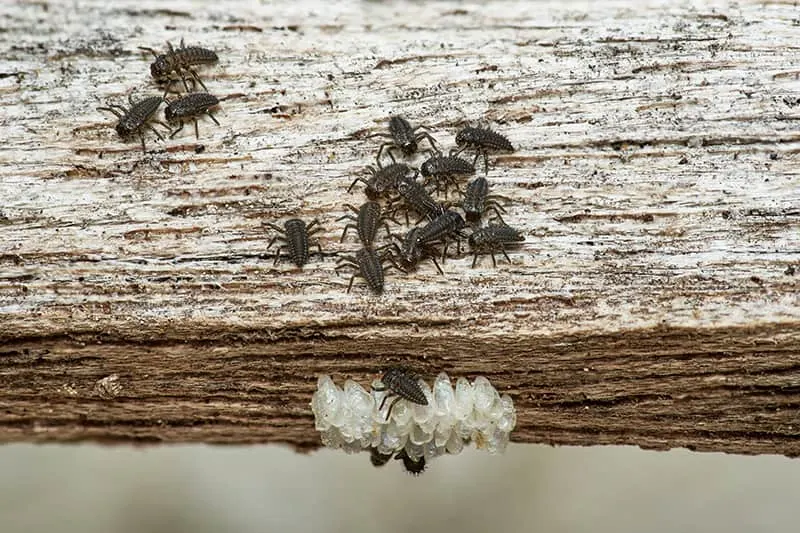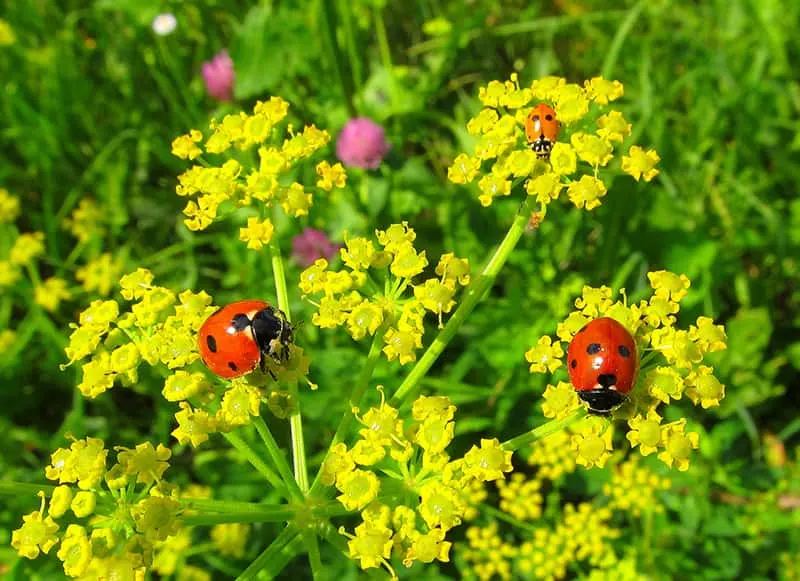Want to learn some fun facts about ladybugs for kids? You’ll find them in this post. We’ll talk about their physical description, diet, life cycle, and more!

Ladybugs are actually beetles. In the United States, they're called ladybugs. Outside of the United States, they are called ladybird beetles, or ladybirds.
There are about six thousand different types of ladybug species worldwide. There are almost five hundred species of ladybugs in North America.
Ladybugs come in different colors. They have different markings, other than spots. For the purposes of this article, we will be talking about the seven-spotted lady beetle. This ladybug is one of the most common ladybugs found in the United States and Europe.
Physical Description
The seven-spotted ladybug resembles the classic ladybug with its shiny, red-domed shell and black spots. These ladybugs are about half an inch long and have seven black spots on their shell. There are three spots on each half of the shell.
The seventh spot is a large spot located in the middle near the head. There are two white rectangles on either side of this large spot. The head and body of this ladybug make an oval shape. The ladybug’s shell completes the half-circle form of the head.
Seven-spotted ladybugs have a black head with a white dot over each eye. They have two antennae and three pairs of jointed legs.
Habitat
The seven-spotted ladybug can be found all over the world. Almost every country in Africa, Asia, Europe, North America, India, and the Middle East has spotted ladybugs. These ladybugs are also present in a wide range of habitats.
Their diverse habitats include alfalfa fields, home gardens, city parks, and forests. They have even been found under rocks in the alpine tundra, where trees cannot grow. Ladybugs live in any area where they can catch a lot of prey.
Habits
Seven-spotted ladybugs are active during the day when it’s warm. They are solitary creatures but gather in swarms during the winter. When the temperature drops, these ladybugs use wind currents to migrate to a warmer location.
Ladybugs detect the pheromones given off by other ladybugs. They cluster at the same sites, generation after generation. They gather in rocks, trees, or vegetation to overwinter.
Once the ladybugs are in the swarm, they enter a state of hibernation. These ladybugs barely move or eat until the weather warms up in spring.
Seven-spotted ladybugs have a fascinating defense against predators. The seven-spotted ladybug’s color sends a message to its predator that the ladybug is poisonous. The color of this ladybug is its first defense.
The second defense is that ladybugs really are poisonous to their predators. Ladybugs have poisonous blood toxins.
The seven-spotted ladybug’s third defense is that it tastes bitter. These ladybugs produce a bitter tasting liquid from their knees when they feel threatened. This liquid also smells bad.
Finally, ladybugs protect themselves from predators by playing dead. A ladybug with “warning” colors, a terrible smell, and an old and dead body is unlikely to be eaten by a predator. Predators quickly decide that a ladybug doesn’t make a tasty snack.
Diet
The seven-spotted ladybug is carnivorous. Its favorite meal is aphids. Ladybugs consume between fifty and a hundred aphids a day. They also eat other types of insects, insect larvae, and eggs.

Offspring
When temperatures warm up, adult ladybugs may mate with each other before leaving their winter colony. Seven-spotted ladybugs mate about five times a day with different partners.
In the late spring to early summer, female ladybugs lay their eggs. They lay between five and thirty eggs in a cluster each time. The eggs take anywhere from three to ten days to hatch. The warmer it is, the less time it takes. Seven-spotted ladybugs can lay anywhere from two hundred and fifty to five hundred eggs over their lifetimes.
Life Cycle of Ladybugs
All ladybugs have a life cycle with four stages.
First Stage: Egg
The first stage is the egg. Ladybug eggs are typically laid on a leaf. The football-shaped eggs are about the same size as a pencil point. They are one millimeter long.
Second Stage: Larva
Ladybug larvae look like tiny, hairless, black caterpillars when they hatch. When they hatch, they start eating right away. They devour egg casings and the fluid from aphids.
The larvae molt as they eat and grow. When a larva outgrows its soft exoskeleton, it sheds it for a new one. As larvae molt, they graduate to eating whole insects and insect eggs. The larva of a seven-spotted ladybug molts a total of four times.

Third Stage: Pupae
Seven-spotted ladybug larvae don't eat for twenty-four hours before they go through the pupae stage. Then they attach to a leaf or other object.
A weird transformation occurs at this stage. The larva’s body changes into a ladybug-like body. This happens through a biochemical process. The ladybug pupa resembles a squishy ladybug. The pupae stage lasts from one to two weeks.
Fourth Stage: Adult
When the pupa changes into an adult ladybug, the ladybug has a soft exoskeleton. The exoskeleton hardens over time. Their wings have developed by this time and are tucked away under their exoskeleton shell.
Ladybugs have two pairs of wings tucked away. The larger, tougher outer wings serve as a shield for the smaller, more fragile inner wings. The ladybug’s pair of inner wings are the ones that allow it to fly.
Check out this video showing how the seven spotted ladybug folds its wings.
Classification/Taxonomy
Kingdom: Animalia
Phylum: Arthropoda
Class: Insecta
Order: Coleoptera
Family: Coccinellidae
Genus: Coccinella
Species: Coccinella septempunctata
History
Scientists believe that insects may have evolved from crustaceans. Most modern beetles evolved about sixty-six million years ago. There are more types of beetle than any other creature.
Ladybugs evolved as one of the many beetle families. Seven-spotted ladybugs are native to Europe. People brought them to North America in the 1900s to help control aphids.
How the Ladybug Got its Name
A long time ago, farmers in Europe prayed to the Virgin Mary of the Catholic Church. They prayed for her to get rid of the insects that were eating all their crops. After they prayed, they saw ladybugs come and eat all the harmful insects. They called the ladybug the “beetle of Our Lady.” Over the years, this was shortened to “lady beetle” and “ladybug”.
Predators
The main predators of seven-spotted ladybugs are birds. Ladybugs are also eaten by frogs and other insects such as wasps, dragonflies, and ants.
Lifespan
The entire lifecycle of a seven-spotted ladybug takes one year to complete. Once an adult, the seven-spotted ladybug typically lives for another year. The ladybug has about a two-year life span from when it hatches to the end of its adult stage.
The seven-spotted ladybug is thriving. Most species of ladybugs are thriving, but there are some rare ladybugs.

25+ Fascinating Ladybug Facts
- In 5 U.S. states, the seven-spotted lady beetle is the official state insect.
- Ladybugs have poor vision. They can only see if it's light or dark.
- Ladybugs smell with their feet.
- Ladybugs use their sense of smell to find prey.
- Ladybugs have a poor sense of direction when flying.
- Ladybugs can hibernate for up to nine months.
- During their lifetime, ladybugs consume roughly 5,000 aphids.
- It is difficult to determine the difference between a male and a female seven-spotted ladybug. The females are usually larger.
- A female ladybug can produce more than 1,000 eggs in a cluster.
- The time periods between ladybug larva molts are called “instars.”
- The four-stage lifecycle of a ladybug is known as a “complete metamorphosis”.
- Ladybugs eat pollen when they can't find insects to eat.
- Farmers love ladybugs because they eat insects that harm crops.
- Many cultures all over the world consider ladybugs to be a symbol of good luck.
- Ladybugs have been called ladybirds, lady beetles, lady clocks, lady cows, and lady flies.
- Common ladybugs typically have 2 to 7 spots.
- Some ladybugs have stripes instead of spots, or no markings at all.
- Ladybugs don't just have black markings on their bodies. The markings come in many colors.
- A ladybug plays dead to fool its predator into thinking it is too old to eat.
- A ladybug's bright colors warn predators that they are toxic.
- Ladybugs can be many colors, including white, pink, and black.
- Newly hatched larvae consume the infertile eggs in their cluster.
- It is a bad idea to release ladybugs inside your house to help with houseplants.
- Some ladybug species are good garden pest controllers.
- Asian lady beetles are a type of ladybug that often invades houses and becomes a pest.
- Ladybugs are better swimmers than other insects.
- Ladybugs will swim or float to reach dry land.
- Ladybugs sometimes drink from the water puddles on leaves.
- Ladybugs typically get their fluid from insects and nectar.
- Ladybugs flap their wings about 5,000 times per minute, or roughly 85 times per second.
- Ladybugs can fly at speeds of up to 37 miles an hour, which is quicker than the average horse.
- Ladybugs can fly for up to 2 hours before landing.
- Ladybugs can fly as high as 3,600 feet. This is roughly twice the height of the Empire State Building.
We hope you had fun learning all about ladybugs! Did you learn anything new? Let us know what other fun facts you know about them. We’re excited to find out more.
Here are some fun insects that you might want to learn about.
